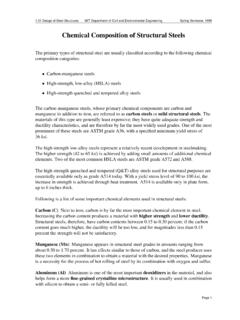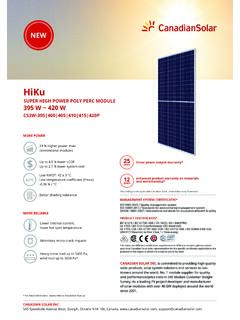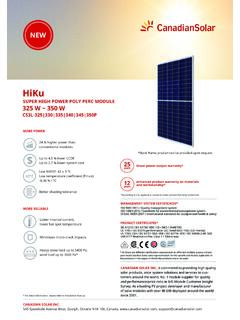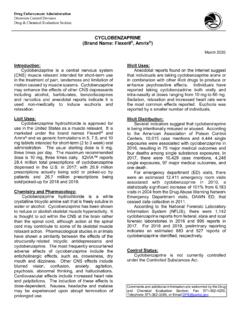Transcription of Silicon processing: from quartz to crystalline silicon ...
1 Southern African Pyrometallurgy 2011, Edited by Jones & P. den Hoed, Southern African Institute of Mining and Metallurgy, Johannesburg, 6-9 March 2011 83 Silicon processing: from quartz to crystalline Silicon solar cells Xakalashe1,2 and M. Tangstad2 Mintek, Randburg, South Africa1; NTNU, Trondheim, Norway2 Keywords: Pyrometallurgy, Silicon , solar cells Abstract Silicon has been the dominant material in the photovoltaic (PV) industry since its application in the space industry in 1958. This review focuses on crystalline Silicon solar cells, primarily due to their dominance in the photovoltaic industry, omitting other photovoltaic cell technologies such as second generation ( thin films) and third generation ( nano-structured solar cells). The value chain for the production of crystalline Silicon solar cells has been reviewed. The primary processing steps for the production of Silicon solar cells from quartz are as follows: bulk production of metallurgical-grade Silicon via carbothermic reduction in a submerged furnace, refining of metallurgical-grade Silicon via the chemical means to polycrystalline Silicon , or through the metallurgical route to solar-grade Silicon , wafer manufacturing, and, lastly, Silicon solar cell manufacturing.
2 During downstream processing, solar cells are interconnected and encapsulated into solar modules (panels), which can be used individually or incorporated into a photovoltaic system for electricity generation and supply. The cost for crystalline Silicon based solar cells is approaching one US dollar per watt peak ($1/Wp), while the most cost-effective solar modules in industry have reported costs below $1/Wp, and are based on CdTe thin films. Solar cell energy conversion efficiencies as high as 22% have been reported in industry for crystalline Silicon solar cells. INTRODUCTION The unsustainable nature of fossil fuels as an energy source, from the point of view of future availability and environmental impact, has spurred an interest in diversification of energy sources, with particular interest in renewable energy. The photovoltaic (PV) industry is a player in the renewable energy segment, and the electricity generation from photovoltaics (solar cells) is deemed to be one of the key technologies of the 21st Photovoltaic solar electricity presents an elegant means for electricity generation, as there are no moving parts, zero emissions, and no noise.
3 The photovoltaic industry is booming, growing at double-digit growth rates per annum2, and is anticipated to maintain this boom for years to come3,4. The dominant material used in PV cells is Silicon , particularly multi- crystalline silicon5. The multi- crystalline Silicon market share for PV applications accounted for nearly half of the total PV materials in 2009 6. Its preference over mono- crystalline Silicon is due to lower production costs while maintaining relatively high energy conversion efficiency as a solar cell. The dominance of 84 the crystalline Silicon can be attributed to the maturity of the technology, and lower direct production costs, with a potential for further reduction in costs compared to other photovoltaic technologies7. crystalline Silicon is expected to maintain its lead in the near future8,9. A brief history of the origins of modern solar cells is given, and Silicon s position in relation to other materials as a solar cell material is evaluated.
4 Until 1997, the Silicon used in the production of solar cells was sourced from waste materials from the electronic industry1. Subsequently, this became unsustainable due to a mismatch in supply-demand of Silicon between the PV industry and the electronic industry, and the costs associated with Moreover, the chemical purity requirements of electronic-grade Silicon are much more stringent than those of solar-grade Silicon . Consequently, technologies for a new Silicon feedstock, the solar-grade Silicon , tailored for the PV market had to be developed. Two main routes have been developed, or are currently under development, exclusively for the industrial production of Silicon for the PV industry, and these are the chemical route and the metallurgical route1. An appraisal of these processing routes is given in this paper. The precursor material for both electronic-grade Silicon and solar-grade Silicon is metallurgical-grade Silicon .
5 Once solar-grade Silicon is produced, the subsequent processing steps are as follows: wafer production, solar cells manufacture. A short description of these processing steps will be given in the paper. Solar cells are assembled into solar modules for electricity generation. The flowsheets for the production of Silicon solar cells from quartz via both the chemical route and the metallurgical route are shown in Figure 1. METALLURGICAL ROUTEQ uartzCHEMICAL ROUTEQ uartzCarbothermic reductionCarbothermic reductionMetallurgical-grade siliconMetallurgical-grade siliconChemical purificationMetallurgical purification PolysiliconSolar-grade Silicon (upgraded metallurgical-grade Silicon )Wafer productionMono- crystalline Silicon wafersMulti- crystalline Silicon wafersProduction of solar cellsWafer productionMono- crystalline Silicon wafersMulti- crystalline Silicon wafersProduction of solar cellsCrystalline Silicon solar cellsCrystalline Silicon solar cells Figure 1: Stages for the production of crystalline Silicon solar cells from quartz 85 ORIGIN OF Silicon SOLAR CELLS Solar cells generate electricity as a result of the photovoltaic effect.
6 It was not until 1839 that the photovoltaic effect was reported for the first time by Alexandre-Edmund Bequerel, who observed that electrical currents were generated from light-dependence on a silver-coated platinum electrode immersed in an electrolyte10. A similar effect was observed in an entirely solid-state system in 1876, comprising a selenium sample and platinum contacts. The first modern Silicon solar cell was developed at Bell Laboratories in 1954 by Chapin, Fuller, and Pearson, and had an energy conversion efficiency of 6% 11. In the same year, a cadmium sulphide thin-film solar cell was produced and had an energy conversion efficiency of the same order of magnitude as the Silicon solar cell11. These efficiencies were remarkable, as solar cells developed up to this point showed energy conversion efficiencies between and In 1956, gallium arsenide (GaAs) solar cells with energy conversion efficiency of 6% were reported from Radio Corporation of America (RCA).
7 By 1956, Silicon solar cells showed efficiencies as high as 10%. It is reported that the first indium phosphide (InP) and CdTe solar cells were made at RCA, and the best efficiency of these cells was reported as approximately 2% in 1959. The first major application of solar cells was in 1958, when the USA launched the first satellite using a PV power supply. Silicon solar cells were used for this mission, and up until today Silicon solar cells remain the most dominant in the photovoltaic market. Silicon solar cell technology benefited greatly from the Silicon technology developed for the electronic industry8. IS Silicon THE IDEAL SOLAR CELL MATERIAL? As the focus of this paper is on Silicon in solar cells, and the basis for electricity generation is the photovoltaic effect, an important question to answer is whether Silicon is the ideal solar cell material or not.
8 To answer this question, it is important to consider the relevant chemical, physical, and electrical properties of Silicon . First and foremost, Silicon is an indirect band gap semiconductor. Therefore, on the energy crystal momentum plot, the minimum energy in the conduction band and the maximum energy in the valence band occur at different values of crystal momentum. Consequently, the probability of light being absorbed is much lower than in the direct band gap18. Light can pass a reasonable distance into the indirect band gap semiconductor prior to absorption. This has adverse consequences when considering the amount of material used; only 1 micron of GaAs (a direct band gap semiconductor) is needed to absorb an equivalent light that is absorbed by 100 microns of silicon8. The solar cell energy conversion efficiency limits, as a function of the band gap of the semiconductor material, can also be used to benchmark Silicon against other semiconductor material (see Figure 2).
9 86 Figure 2: Solar cell energy conversion efficiency limits, as a function of the band gap of the semiconductor material, at different radiation12 The solar cell energy conversion efficiency limits shown in Figure 2 are at the following radiations: air mass zero (AM0), air mass ( ), and for a black body under air mass zero (AM0). It is known that each photon absorbed by a semiconductor material creates one electron-hole pair regardless of its energy. Moreover, only photons with energy greater than or equal to the band gap of a semiconductor are absorbed by that semiconductor. Therefore, the plot of efficiency as a function of semiconductor band gap has a maximum energy conversion efficiency. As can be seen from the figure, Silicon s band gap is below the maximum, which is between and electron volt (eV). It is clear from its properties that Silicon is not the ideal material for solar energy conversion.
10 It is no surprise that there is extensive research going into the search for new materials for solar cells. Thin-film semiconductors are gaining popularity in industry, particularly cadmium telluride (CdTe), which is only second to crystalline Silicon in terms of market share in the photovoltaic industry. Cadmium telluride is both a direct band gap semiconductor and has a band gap within the optimum band gap. There are other important factors to be considered for an ideal solar cell material; these include: material availability, non-toxic materials, easy production methods suitable for mass production, sound photovoltaic conversion efficiency, and long term stability of the solar cell material12. As 87 mentioned previously, the dominance of Silicon in the photovoltaic industry is attributed to historic reasons, availability of high -quality material in large quantities for the semiconductor market12.







